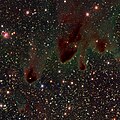|
Gum Nebula
The Gum Nebula (Gum 12) is an emission nebula that extends across 36° in the southern constellations Vela and Puppis. It lies approximately 450 parsecs from the Earth.[1] Hard to distinguish, it was widely believed to be the greatly expanded (and still expanding) remains of a supernova that took place about a million years ago. More recent research suggests it may be an evolved H II region. It contains the 11,000-year-old Vela Supernova Remnant, along with the Vela Pulsar. The Gum Nebula contains about 32 cometary globules.[2] These dense cloud cores are subject to such strong radiation from O-type stars γ2 Vel and ζ Pup and formerly the progenitor of the Vela Supernova Remnant that the cloud cores evaporate away from the hot stars into comet-like shapes. Like ordinary Bok globules, cometary globules are believed to be associated with star formation.[3] A notable object inside one of these cometary globules is the Herbig-Haro object HH 46/47. It is named after its discoverer, the Australian astronomer Colin Stanley Gum (1924–1960). Gum had published his findings in 1955 in a work called A study of diffuse southern H-alpha nebulae (see Gum catalog). He also published the discovery of the Gum Nebula in 1952 in the journal The Observatory. The observations were made with the Commonwealth Observatory.[4] The Gum nebula was photographed during Apollo 16 while the command module was in the double umbra of the Sun and Earth, using high-speed Kodak film.[5] Popular cultureThe Gum Nebula is explored by the crew of the Starship Titan in the Star Trek novel Orion's Hounds.[6] Gallery
See alsoReferences
External linksWikimedia Commons has media related to Gum 12.
|
||||||||||||||||||||||||||||




